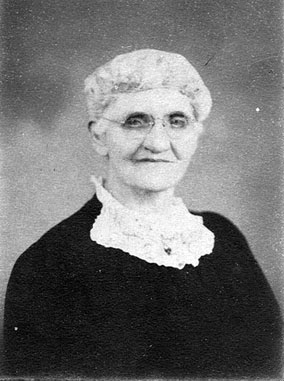Fundy Fisherman (Blacks Harbour Newspaper) 1946
Mrs. Lola Jane Bradford who resides with her daughter, Mrs. Chipman M. Brewer of Blacks Harbour, celebrated her 80th Birthday on May 6th. One of the older residents of the village, she is perhaps the most noted having brought here in 1895 by Pat and Lewis Connors, founders pf the firm pf Connors Bros. Limited, to instruct the women of the village in the art of packing sardines and she packed the first sardines shown at the Saint John Exhibition in 1896.
A cheerful, interesting person, known as Grandma Bradford to the whole village, she is the mother of eighteen children, eleven of whom are living, and also has 83 grandchildren and 48 great-grandchildren, making a total of 141 living descendants of whom 95 are resident in Blacks Harbour. She also has 10 grandchildren deceased.

Mrs. Lola May (Barney) Bradford, in 1946
She was born at Saco, Maine, on May 6th, 1866, daughter of Ora Barney who came out from Ireland at the age of eight years and Florella Tucker, a native of Saco, Maine. On April 21st, 1882, just before her sixteenth birthday, she married Martin Byrne Bradford and went to reside in Eastport, Maine, where six children were born, Victor H. Sr. of Blacks Harbour, Harold of Oak Bay, NB, Bailey and Royce (both deceased in infancy), Kathleen (Mrs. Warren Justason) and Helen (Mrs. John Justason) both of Blacks Harbour. Mrs. Bradford was employed packing sardines at MacLean's factory while in Eastport and after living there for nearly ten years she moved to Beaver Harbour, NB, to pack sardines for Lewis Holmes who had a cannery there. Two children, Martin (killed in France in 1918) and Eric (who died of wounds after returning home in 1919) were born at Beaver Harbour.
In 1895 Pat and Lewis Connors started the Canadian company, Connors Bros. Limited, which was to become world famous for its sardines, and Mrs. Bradford was persuaded to move to Blacks Harbour and instruct the women how to pack sardines. The remainder of her family, ten children, were born here: Windfield W., Gladys (Mrs. Chipman Brewer) , Mildred (Mrs. Wesley Leavitt), Lola and Avis (deceased in infancy), Myles, Donald, Ernest (deceased in 1943), Freda (Mrs. Wendell Estabrooks of Marysville, NB) and Theodore.
She had four brothers who served in the American Civil war of 1861-1865, three of whom were killed in action. Four sons server in World War One, two of whole were killed, and her youngest son, Theodore, served overseas all during the Second World War She also had ten grandsons in the Army: Eric, Martin, Donald, Norman, and Theodore A. Bradford.; Reginald, Arnold, Robert and George Justason; and Wesley Leavitt; two grandsons with the R.C.A.F.: James Estabrooks and Hazen Bradford, and her granddaughter Gladys (Justason) Skerrett had the distinction of being the only girl from this village to serve overseas.
Mrs. Bradford has grown up in the sardine industry and remembers vividly the gay nineties when the company first started here. The women received 12¢ per case for packing the fish and the average wage for a man was $1.25 to $1.50 per day. Four hundred cases was a large shipment and all the work was done by hand. First, the cans were hand-made. The tinplate was brought in by boat and the material for the rims was then taken to Eastport to be decorated and the lettering was all on the side of the can instead of the top as today. The bottoms and covers were identical rectangular pieces and so a ring was placed on the cover to distinguish it. When the tin arrived back from Eastport, it was cut into strips 7/8" wide and the proper length by a pair of shears operated by foot-power. The rims were bent into a rectangular shape, the ends soldered together, and the bottom piece was then pushed down inside and soldered in by a can-maker. The soldering was done on a device called a "whirl-a-gig". This was a round piece of iron shaped like a stove cover, an iron rod 3' long went down through the middle and the sharp end of the rod was set into a block on the floor. A top iron piece came to table height and has a Hinchley clasp which held the can in place. The device could be rotated by moving the feet on the lower piece of the iron enabling the can-maker to solder the whole can without turning it by hand. Cook stoves were used first for heating the soldering irons and later kerosene stoves. A good can-maker could solder 300 and sometimes 400 cans per hour.
The tiny fish arrived by boat as today but were hoisted out by hand and wheeled into the factory where they were pickled in tanks made of hogshead. When taken from the brine they were placed crosswise on wooden racks made of slats and set in the sun an hour to dry or if the weather was unfavorable the flakes were placed in a dry house on the second floor and stoves downstairs provided the necessary heat for drying.
After flaking, the fish were placed in a wire basket which was passed by hand through a 15' tank filled with boiling oil and with steam pipes in the bottom. After being fried in oil they were lifted out to cool and drain before being packed.
The packers standing at a table placed the fish in cans and they also had to oil and head their cans. One ladle of oil from a bucket in the middle of the table was placed in each can of fish. Each packer had what was known as a "Header" which was a piece of iron four or five inches long, ½"wide and 1½" thick with a thin lip in the end of it. The top of the can was laid on and the header used to fit the cover down into the can.
The can then went to the sealer who soldered the covers on the same as the bottoms. Each sealer had his own mark which he placed in the ring on the cover and he was fined one cent for each leaky can, but got only 25¢ per 100 good tins.
After sealing, the cans were dumped into a large tank of water at the boiling point and left for an hour and a half. They were then dumped out on the wooden floor of the building, covered with sawdust and left for twenty minutes, turned over and over and raked through a trap door in the floor, dropping they rolled along slats which removed the sawdust and cleaned the cans which were then picked off by hand and packed in wooden boxes for shipment to various parts of the province.
Comparison between the methods of the nineties (1890s) and those of the 1940's shows the progress of the machine age, the saving in time and labour, and the increase in productive capacity. Today the can proper is pressed out of a sheet of tin in one piece by a can-press and the covers are also machine made. The fish still arrive by boat but are dipped out by automatic hoists and passed down a sluice onto a wire screen which removes the water and fish scales and the scaled fish pass on to a carrier that delivers them to the flaking machine which lays the fish separately on the flakes. These flakes are lifted off by hand and placed in the steam racks which hold twenty-five flakes and they are placed in the steam box and cooked according to the size of the fish. The racks are wheeled from the steam boxes and put in the drier and from here are put on conveyors and passed into the packing room where the women remove the heads and tails with scissors and placed the fish in the cans as of old. The cans are placed on trays of twenty-five each and when four trays are ready they are lifted off by hand, wheeled to an automatic oiler which does the 25 tines at one time and they are then taken to the sealing or closing machine where the covers are laid on by hand and the operation completed. From here the tins pass by conveyor belt to the retorts where they are processed and they are raked out of the retorts through a door in the bottom onto a wire conveyor belt which carries them through the washer and rinse water dumping them onto another belt which takes them into the shipping room where they are cooled and then packed in wooden boxes for shipment, being now well-known in practically every county of the world.
Mrs. Bradford has the distinction of being the only woman to hold the position of foreman in the packing room here. Always ready and willing to help, during World War One when men were scarce she acted as foreman for two years and every season since and during World War Two she has worked in some capacity in the plant.
Her husband, Martin B. Bradford Sr., died February 24th, 1917. She is a staunch member of the United Baptist Church, has a deep interest in the welfare of the village in which she has spent much of her life, and attributes her long life to Christian living and plenty of exercise, especially walking.

BRADFORD, LOLA JANE (BARNEY) - Woman Who Packed First Connors Bros. Sardines Was Mother of 18 - Mr. Lola Jane Bradford, aged 83 years, died at the home of her daughter, Mrs. Chipman H. Brewer Sunday evening, May 22 1949, following an illness of several months. She had been an outstanding figure in community life and church work during her years of residence here in Blacks Harbour. Mrs. Bradford learned to pack fish in Eastport and upon moving to Blacks Harbour in 1895 she packed the first sardines for Connors Brothers and instructed others. She also packed the first sardines shown by Connors Brothers at the Saint John Exhibition for which the firm won a medal. Formerly Lola Barney, she was born in Saco, Maine, May 6, 1866. Shortly after moving to Eastport in 1882, she married Martin B. Bradford. Six of her children were born in Eastport. In 1892 the family moved to Beaver Harbour where two more children were born. In April 1895, they moved to Blacks Harbour where ten children were born making 18 in all. There are eleven children now living: Victor H. Bradford, Donald Bradford, Mrs. Chipman H. Brewer, Mrs. Warren Justason, Mrs. John Justason and Mrs. Wesley Leavitt Sr. all of Blacks Harbour, and Mrs. Wendall Estabrooks of Marysville; Winfield, Miles and Theodore, of Pennfield, and Harold Bradford of Oak Bay. She is also survived by 82 living grandchildren and 83 living great-grandchildren. Mrs. Bradford has four brothers who served in the American Civil War, four sons in the First World War, one killed in active service and one who died of a wound after returning home. In the Second World War, she had one son in active service, also eleven grandsons and one granddaughter. Mrs. Bradford has been a member of the Baptist Church longer than anyone else in the village, having first joined as a girl in Maine. She was a staunch member of Calvary United Baptist Church. Her husband, Martin Bradford, predeceased her February 24, 1917. The funeral was held at Calvary United Baptist Church at 2:30 Wednesday, Rev. William Randall conducting the service assisted by H. S. Wilson of the Reformed Baptist Church.


Updated: 21 April 2016
www.HeritageCharlotte.com/Bradford/
Copyright ©2006-2021 Jason N. Gaudet/Heritage Charlotte All rights reserved



